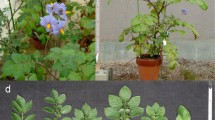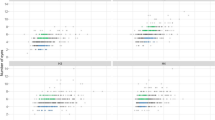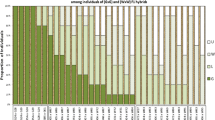Abstract
Wild Solanum species offer a valuable source of genetic diversity for potato improvement. Most of these species are found in equatorial South and Central America and they do not tuberise under long-day photoperiods typical of those in the major potato production areas of North America, Europe and Asia. Crosses between two haploids of Solanum tuberosum Chilotanum Group as females and two wild Solanum species clones generated four hybrid families. The parents and progeny were subjected to two greenhouse trials to evaluate tuberisation at 20-, 14-, and 8-h photoperiods. Parents and offspring tuberised most readily at the 8-h photoperiod, and poorly or not at all at the 20-h photoperiod. Segregation for tuberisation in hybrids was apparent at the 14-h photoperiod and depended on the cultivated parent, but not the wild species parent. The data support previous studies and best fit a model in which tuber production under long photoperiods is controlled by two dominant genes in cultivated × wild species hybrids.


Similar content being viewed by others
References
Banerjee AK, Chatterjee M, Yu Y, Suh S-G, Miller WA, Hannapel DJ (2006) Dynamics of a mobile RNA of potato involved in a long-distance signaling pathway. Plant Cell 18(12):3443–3457
Batutis EJ, Ewing EE (1982) Far-red reversal of red light effect during long-night induction of potato (Solanum tuberosum L.) tuberization. Plant Physiol 69:672–674
Bisognin DA, Douches DS (2002) Early generation selection for potato tuber quality in progenies of late blight resistant parents. Euphytica 127:1–9
Bradshaw J, Bryan G, Ramsay G (2006) Genetic resources (including wild and cultivated Solanum species) and progress in their utilisation in potato breeding. Potato Res 49(1):49–65
Cardi T, Ambrosio FD, Consoli D, Puite KJ, Ramulu KS (1993) Production of somatic hybrids between frost-tolerant Solanum commersonii and S. tuberosum: characterization of hybrid plants. Theor Appl Genet 87:193–200
Carrera E, Jackson SD, Prat S (1999) Potato GA 20-oxidases show a diurnal rhythmicity that is altered by a short interruption of the dark period. Plant Physiol 119:765–773
Chen H, Rosin FM, Prat S, Hannapel DJ (2003) Interacting transcription factors from the three-amino acid loop extension superclass regulate tuber formation. Plant Physiol 132:1391–1404
Chincinska IA, Liesche J, Krugel U, Michalska J, Geigenberger P, Grimm B, Kuhn C (2008) Sucrose transporter StSUT4 from potato affects flowering, tuberization, and shade avoidance response. Plant Physiol 146(2):515–528
Culley D, Dean B, Brown C (2002) Introgression of the low browning trait from the wild Mexican species Solanum hjertingii into cultivated potato (S. tuberosum L.). Euphytica 125(3):293
Ewing EE, Struik PC (1992) Tuber formation in potato: induction, initiation, and growth. Hortic Rev 14:89–198
Ewing EE, Wareing PF (1978) Shoot, stolon, and tuber formation on potato (Solanum tuberosum L) cuttings in response to photoperiod. Plant Physiol 61:348–353
Garner WW, Allard HA (1923) Further studies in photo-periodism. The response of the plant to relative length of day and night. J Agric Res 18:553–606
Ghislain M, Núñez J, del Rosario HM, Spooner DM (2009) The single Andigenum origin of neo-Tuberosum materials is not supported by microsatellite and plastid marker analyses. Theor Appl Genet 118:963–969
Glendinning DR (1969) The performance of progenies obtained by crossing groups Andigena and Tuberosum of Solanum tuberosum. Eur Potato J 12:13–19
Glendinning DR (1975a) Chilean potatoes: an appraisal. Potato Res 18:306–307
Glendinning DR (1975b) Neo-Tuberosum: new potato breeding material. 1. The origin, composition, and development of the Tuberosum and Neo-Tuberosum genepools. Potato Res 18:256–261
Glendinning DR (1975c) Neo-Tuberosum: new potato breeding material. 2. A comparison of Neo-Tuberosum with unselected Andigena and Tuberosum. Potato Res 18:343–350
Gregory LE (1956) Some factors for tuberization in the potato plant. Am J Bot 43:281–288
Hamernik AJ, Hanneman RE Jr, Jansky S (2009) Introgression of wild species germplasm with extreme resistance to cold sweetening into the cultivated potato. Crop Sci 49:529–542
Hannapel DJ (2010) A model system of development regulated by the long-distance transport of mRNA. J Integr Plant Biol 52:40–52
Hannapel D, Chen H, Rosin FM, Banerjee AK, Davies PJ (2004) Molecular controls of tuberization. Am J Potato Res 81:263–274
Hanneman RE Jr (1989) The potato germplasm resource. Am Potato J 66:655–667
Hanneman RE Jr, Ruhde RW (1978) Comparison of bulk populations of species and species-haploid hybrids for tuberization and yield. Am Potato J 55:377
Hawkes JG (1990) The potato: evolution, biodiversity, and genetic resources. Smithsonian Institution Press, Washington, D.C.
Hermundstad SA, Peloquin SJ (1985) Germplasm enhancement with potato haploids. J Hered 76:463–467
Hijmans RJ, Spooner DM, Salas AR, Guarino L, de la Cruz J (2002) Atlas of wild potatoes. International Plant Genetic Resources Institute, Rome
Hougas RW, Ross RW (1956) The use of foreign introductions in breeding American potato varieties. Am Potato J 33(11):328–339
Jacobsen TL, Jansky SH (1989) Effects of pre-breeding wild species on tuberization of Solanum tuberosum haploid-wild species hybrids. Am Potato J 66:803–811
Jansen G, Flamme W, Schuler K, Vandrey M (2001) Tuber and starch quality of wild and cultivated potato species and cultivars. Potato Res 44:137–146
Jansky S (2000) Breeding for disease resistance in potato. Plant Breed Rev 19:69–155
Jansky SH (2011) Parental effects on the performance of cultivated × wild species hybrids in potato. Euphytica 178:273–281
Jansky SH, Peloquin SJ (2006) Advantages of wild diploid Solanum species over cultivated diploid relatives in potato breeding programs. Genet Resour Crop Evol 53:669–674
Jansky SH, Davis GL, Peloquin SJ (2004) A genetic model for tuberization in potato haploid-wild species hybrids grown under long-day conditions. Am J Potato Res 81:335–339
Kenward M, Roger J (1997) Small sample inference for fixed effects from restricted maximum likelihood. Biometrics 53:983–997
Kittipadakul P (2010) Genetic dissection of tuberization in response to photoperiod in potato. University of Wisconsin, Madison
Krauss A (1985) Interaction of nitrogen nutrition, phytohormones and tuberization. In: Li PH (ed) Potato Physiology. Academic Press, London, pp 209–231
Krauss A, Marschner H (1982) Influence of nitrogen nutrition, daylength, and temperature on contents of gibberelllic and abscisic acid and on tuberization in potato plants. Potato Res 25:13–21
Lewis CE, Walker JRL, Lancaster JE, Sutton KH (1998) Determination of anthocyanins, flavonoids and phenolic acids in potatoes. II: Wild, tuberous Solanum species. J Sci Food Agric 77:58–63
Margulies M, Egholm M, Altman WE, Attiya S, Bader JS, Bemben LA, Berka J, Braverman MS, Chen YJ et al (2005) Genome sequencing in microfabricated high-density picolitre reactors. Nature 437(7057):376
Martin A, Adam H, Díaz-Mendoza M, Zurczak M, González-Schain ND, Suárez-López P (2009) Graft-transmissible induction of potato tuberization by the microRNA miR172. Development 136:2873–2881
Martínez-García JF, García-Martínez JL, Bou J, Prat S (2002) The interaction of gibberellins and photoperiod in the control of potato tuberization. J Plant Growth Regul 20:377–386
McCann LC, Bethke PC, Simon PW (2010) Extensive variation in fried chip color and tuber composition in cold-stored tubers of wild potato (Solanum) germplasm. J Agric Food Chem 58:2368–2376
Mendoza HA, Haynes FL (1977) Inheritance of tuber initiation in tuber bearing Solanum as influenced by photoperiod. Am Potato J 54:243–253
Menzel CM (1980) Tuberization in potato at high temperatures. Responses of gibberellin and growth inhibitors. Ann Bot 46:259–265
Munoz F, Plaisted R (1981) Yield and combining abilities in Andigena potatoes after six cycles of recurrent phenotypic selection for adaptation to long day conditions. Am J Potato Res 58:469–479
Navarro C, Abelenda JA, Cruz-Oro E, Cuellar CA, Tamaki S, Silva J, Shimamoto K, Prat S (2011) Control of flowering and storage organ formation in potato by FLOWERING LOCUS T. Nature 478:119–123
Plaisted RL, Hoopes RW (1989) The past record and future prospects for the use of exotic potato germplasm. Am Potato J 66:603–627
Rasco E, Plaisted R, Ewing E (1980) Photoperiod response and earliness of S. tuberosum ssp. andigena after six cycles of recurrent selection for adaptation to long days. Am J Potato Res 57(9):435–447
Rieman GH, Cooper DC, Hougas RW (1954) Potato varieties from species hybrids. Am Potato J 31:1–11
Rios D, Ghislain M, Rodriguez F, Spooner DM (2007) What is the origin of the European potato? Evidence from Canary Island landraces. Crop Sci 47:1271–1280
Rodriguez-Falcon M, Bou J, Prat S (2006) Seasonal control of tuberization in potato: conserved elements with the flowering response. Annu Rev Plant Biol 57:151–180
Ross H (1979) Wild species and primitive cultivars as ancestors of potato varieties. In: Zeven AC, van Harten AM (eds) Broadening the genetic base of crops, Pudoc, Centre for Agricultural Publishing and Documentation, Wageningen, pp 237–245
Ross H (1986) Potato breeding—problems and perspectives. Paul Parey, Berlin
Sarkar D (2008) The signal transduction pathways controlling in planta tuberization in potato: an emerging synthesis. Plant Cell Rep 27:1–8
Sarkar D (2010) Photoperiodic inhibition of potato tuberization: an update. Plant Growth Regul 62(2):117–125
Spooner DM, Nunez J, Trujillo G, del Rosario HM, Guzma F, Ghislain M (2007) Extensive simple sequence repeat genotyping of potato landraces supports a major reevaluation of their gene pool structure and classification. Proc Natl Acad Sci USA 104:19398–19403
Steward FC, Moreno V, Roca WM (1981) Growth, form and composition of potato plants as affected by environment. Ann Bot-London 48(suppl 2):1–45
Tan MYA, Hutten RCB, Celis C, Park T-H, Niks RE, Visser RGF, van Eck HJ (2008) The RPi-mcd1 locus from Solanum microdontum involved in resistance to Phytophthora infestans, causing a delay in infection, maps on potato chromosome 4 in a cluster of NBS-LRR genes. Mol Plant Microbe Interact 21(7):909–918
Tarn TR, Tai GCC (1977) Heterosis and variation of yield components in F1 hybrids between Group Tuberosum and Group Andigena potatoes. Crop Sci 17:517–521
Tarn TR, Tai GCC (1983) Tuberosum × Tuberosum and Tuberosum × Andigena potato hybrids: Comparisons of families and parents, and breeding strategies for Andigena potatoes in long-day temperate environments. Theor Appl Genet 66:87–91
Tarn TR, Tai GCC, De Jong H (1992) Breeding potatoes for long-day, temperate climates. Plant Breed Rev 9:217–232
The Potato Genome Sequencing Consortium (2011) The Potato Genome Sequencing Project. Genome sequence and analysis of the tuber crop potato. Nature 475:189–195
van den Berg JH, Ewing EE, Plaisted RL, McMurry S, Bonierbale MW (1996) QTL analysis of potato tuberization. Theor Appl Genet 93:307–316
Yerk GL (1989) Haploids, wild species, and 2n gametes in the 4x × 2x breeding scheme in potato. University of Wisconsin, Madison
Yerk GL, Peloquin SJ (1989) Evaluation of tuber traits of 10,2x(2EBN) wild species through haploid × wild species hybrids. Am Potato J 66:731–739
Acknowledgements
Wild Solanum germplasm was supplied by the NRSP-6 Potato Genebank. Partial funding for this research was granted by the Royal Thai Government. Special thanks go to Brian Yandell and Nicholas Keuler, University of Wisconsin–Madison, as well as James B. Holland, North Carolina State University, for advice on statistical analyses.
Author information
Authors and Affiliations
Corresponding author
Rights and permissions
About this article
Cite this article
Kittipadukal, P., Bethke, P.C. & Jansky, S.H. The Effect of Photoperiod on Tuberisation in Cultivated × Wild Potato Species Hybrids. Potato Res. 55, 27–40 (2012). https://doi.org/10.1007/s11540-011-9204-3
Received:
Accepted:
Published:
Issue Date:
DOI: https://doi.org/10.1007/s11540-011-9204-3




